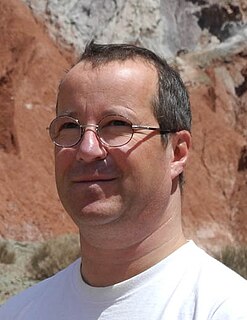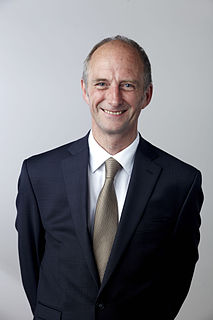Related Research Articles

Potassium channels are the most widely distributed type of ion channel and are found in virtually all living organisms. They form potassium-selective pores that span cell membranes. Potassium channels are found in most cell types and control a wide variety of cell functions.
The two-pore-domain or tandem pore domain potassium channels are a family of 15 members that form what is known as leak channels which possess Goldman-Hodgkin-Katz (open) rectification. These channels are regulated by several mechanisms including signaling lipids, oxygen tension, pH, mechanical stretch, and G-proteins. Their name is derived from the fact that the α subunits consist of four transmembrane segments, and each pair of transmembrane segments contains a pore loop between the two transmembrane segments. Thus, each subunit has two pore loops. As such, they structurally correspond to two inward-rectifier α subunits and thus form dimers in the membrane.

Kv7.2 (KvLQT2) is a voltage- and lipid-gated potassium channel protein coded for by the gene KCNQ2.

Acid-sensing ion channel 1 (ASIC1) also known as amiloride-sensitive cation channel 2, neuronal (ACCN2) or brain sodium channel 2 (BNaC2) is a protein that in humans is encoded by the ASIC1 gene. The ASIC1 gene is one of the five paralogous genes that encode proteins that form trimeric acid-sensing ion channels (ASICs) in mammals. The cDNA of this gene was first cloned in 1996. The ASIC genes have splicing variants that encode different proteins that are called isoforms.

Potassium channel subfamily K member 2 is a protein that in humans is encoded by the KCNK2 gene.

Potassium channel subfamily K member 3 is a protein that in humans is encoded by the KCNK3 gene.

Potassium channel subfamily K member 4 is a protein that in humans is encoded by the KCNK4 gene. KCNK4 protein channels are also called TRAAK channels.

Acid-sensing ion channel 2 (ASIC2) also known as amiloride-sensitive cation channel 1, neuronal (ACCN1) or brain sodium channel 1 (BNaC1) is a protein that in humans is encoded by the ASIC2 gene. The ASIC2 gene is one of the five paralogous genes that encode proteins that form trimeric acid-sensing ion channels (ASICs) in mammals. The cDNA of this gene was first cloned in 1996. The ASIC genes have splicing variants that encode different proteins that are called isoforms.

Potassium voltage-gated channel subfamily B member 2 is a protein that in humans is encoded by the KCNB2 gene. The protein encoded by this gene is a voltage-gated potassium channel subunit.

Potassium voltage-gated channel subfamily V member 1 is a protein that in humans is encoded by the KCNV1 gene. The protein encoded by this gene is a voltage-gated potassium channel subunit.

Potassium voltage-gated channel subfamily S member 2 is a protein that in humans is encoded by the KCNS2 gene. The protein encoded by this gene is a voltage-gated potassium channel subunit.

Potassium channel, subfamily K, member 10, also known as KCNK10 is a human gene. The protein encoded by this gene, K2P10.1, is a potassium channel containing two pore-forming P domains.

Potassium channel blockers are agents which interfere with conduction through potassium channels.
A potassium channel opener is a type of drug which facilitates ion transmission through potassium channels.
Mechanosensitive channels, mechanosensitive ion channels or stretch-gated ion channels (not to be confused with mechanoreceptors). They are present in the membranes of organisms from the three domains of life: bacteria, archaea, and eukarya. They are the sensors for a number of systems including the senses of touch, hearing and balance, as well as participating in cardiovascular regulation and osmotic homeostasis (e.g. thirst). The channels vary in selectivity for the permeating ions from nonselective between anions and cations in bacteria, to cation selective allowing passage Ca2+, K+ and Na+ in eukaryotes, and highly selective K+ channels in bacteria and eukaryotes.

Psalmotoxin (PcTx1) is a spider toxin from the venom of the Trinidad tarantula Psalmopoeus cambridgei. It selectively blocks Acid Sensing Ion Channel 1-a (ASIC1a), which is a proton-gated sodium channel.

Daniel Choquet is a French neuroscientist.

xr

Côte d'Azur University is a public research university located in Nice, France and neighboring areas. In 2019, it replaced the University of Nice Sophia Antipolis and the community (ComUE) that was created in 2013. On 9 January 2020, Jeanick Brisswalter was elected as president of Côte d'Azur University.
Gabriella Gobbi is a Canadian psychiatrist and neuroscientist whose research explores the potential effects of cannabis use in the treatment of mood disorders. Gobbi is a professor at McGill University's Department of Psychiatry and a Canada Research Chair in Therapeutics for Mental Health.
References
- ↑ "Université côte d'Azur".
- ↑ "Académie des sciences".
- ↑ "Arrêté du 2 décembre 1991 portant nomination à l'Institut universitaire de France". Legifrance. Retrieved 8 March 2020.
- ↑ "Arrêté du 8 août 1996 portant nomination des membres seniors et juniors de l'Institut universitaire de France". Legifrance. Retrieved 8 March 2020.
- 1 2 3 4 5 "Michel Lazdunski-Research gate".
- 1 2 3 4 Michel Lazdunski publications indexed by Google Scholar
- ↑ Amoroso, Salvatore; Schmid-Antomarchi, Heidy; Fosset, Michel; Lazdunski, Michel (16 February 1990). "Glucose, Sulfonylureas, and Neurotransmitter Release: Role of ATP-Sensitive K + Channels". Science. American Association for the Advancement of Science (AAAS). 247 (4944): 852–854. Bibcode:1990Sci...247..852A. doi:10.1126/science.2305257. ISSN 0036-8075. PMID 2305257.
- ↑ Waldmann, Rainer; Champigny, Guy; Bassilana, Frédéric; Heurteaux, Catherine; Lazdunski, Michel (1997). "A proton-gated cation channel involved in acid-sensing". Nature. Springer Science and Business Media LLC. 386 (6621): 173–177. Bibcode:1997Natur.386..173W. doi:10.1038/386173a0. ISSN 0028-0836. PMID 9062189. S2CID 4361943.
- ↑ Heurteaux, Catherine; Lucas, Guillaume; Guy, Nicolas; El Yacoubi, Malika; Thümmler, Susanne; Peng, Xiao-Dong; Noble, Florence; Blondeau, Nicolas; Widmann, Catherine; Borsotto, Marc; Gobbi, Gabriella; Vaugeois, Jean-Marie; Debonnel, Guy; Lazdunski, Michel (13 August 2006). "Deletion of the background potassium channel TREK-1 results in a depression-resistant phenotype". Nature Neuroscience. Springer Science and Business Media LLC. 9 (9): 1134–1141. doi:10.1038/nn1749. ISSN 1097-6256. PMID 16906152. S2CID 22729624.
- ↑ Patel, Amanda J.; Honoré, Eric; Lesage, Florian; Fink, Michel; Romey, Georges; Lazdunski, Michel (1999). "Inhalational anesthetics activate two-pore-domain background K+ channels". Nature Neuroscience. Springer Science and Business Media LLC. 2 (5): 422–426. doi:10.1038/8084. ISSN 1097-6256. PMID 10321245. S2CID 23092576.
- ↑ Dalemans, Wilfried; Barbry, Pascal; Champigny, Guy; Jallat, Sophie; Jallat, Sophie; Dott, Karin; Dreyer, Dominique; Crystal, Ronald G.; Pavirani, Andréa; Lecocq, Jean-Pierre; Lazdunski, Michel (1991). "Altered chloride ion channel kinetics associated with the ΔF508 cystic fibrosis mutation". Nature. Springer Science and Business Media LLC. 354 (6354): 526–528. Bibcode:1991Natur.354..526D. doi:10.1038/354526a0. ISSN 0028-0836. PMID 1722027. S2CID 4233457.